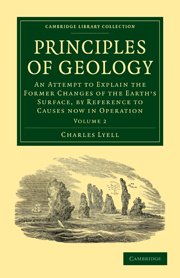 Principles of Geology
Principles of Geology Summary
We have treated hitherto of the imbedding of organic remains in deposits formed upon the emerged land, and we shall next consider the including of the same in deposits formed under water.
It will be convenient to divide this branch of our subject into three parts ; considering first, the various modes whereby the relics of terrestrial species may be buried in subaqueous formations; secondly, the modes whereby the animals and plants inhabiting fresh-water may be so entombed ; thirdly, the manner in which marine species may become preserved in new strata.
The phenomena which we are now about to notice demand a fuller share of attention than those previously examined, since the deposits which originate upon the dry land are insignificant in thickness, superficial extent, and durability, when contrasted with those of subaqueous origin. At the same time, the study of the latter is beset with greater difficulties, for we are here concerned with the results of processes much more removed from the sphere of ordinary observation. There is, indeed, no circumstance, as we before remarked, which more seriously impedes the acquisition of just views in the etiology of our science, than an habitual disregard of the important fact, that the reproductive effects of the principal agents of change are confined to another element,—to that larger portion of the habitable globe, from which, by our very organization, we are almost entirely excluded.
- Type
- Chapter
- Information
- Principles of GeologyAn Attempt to Explain the Former Changes of the Earth's Surface, by Reference to Causes now in Operation, pp. 239 - 252Publisher: Cambridge University PressPrint publication year: 2009First published in: 1832
